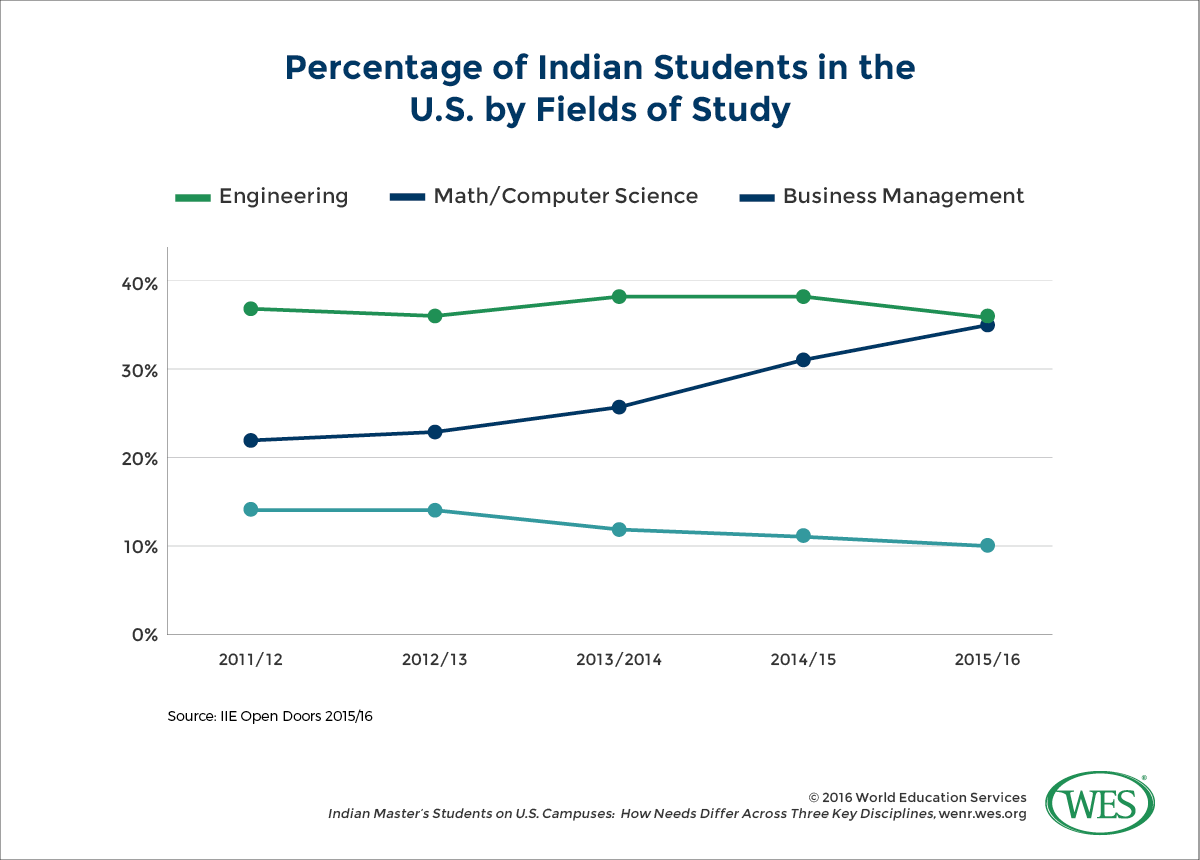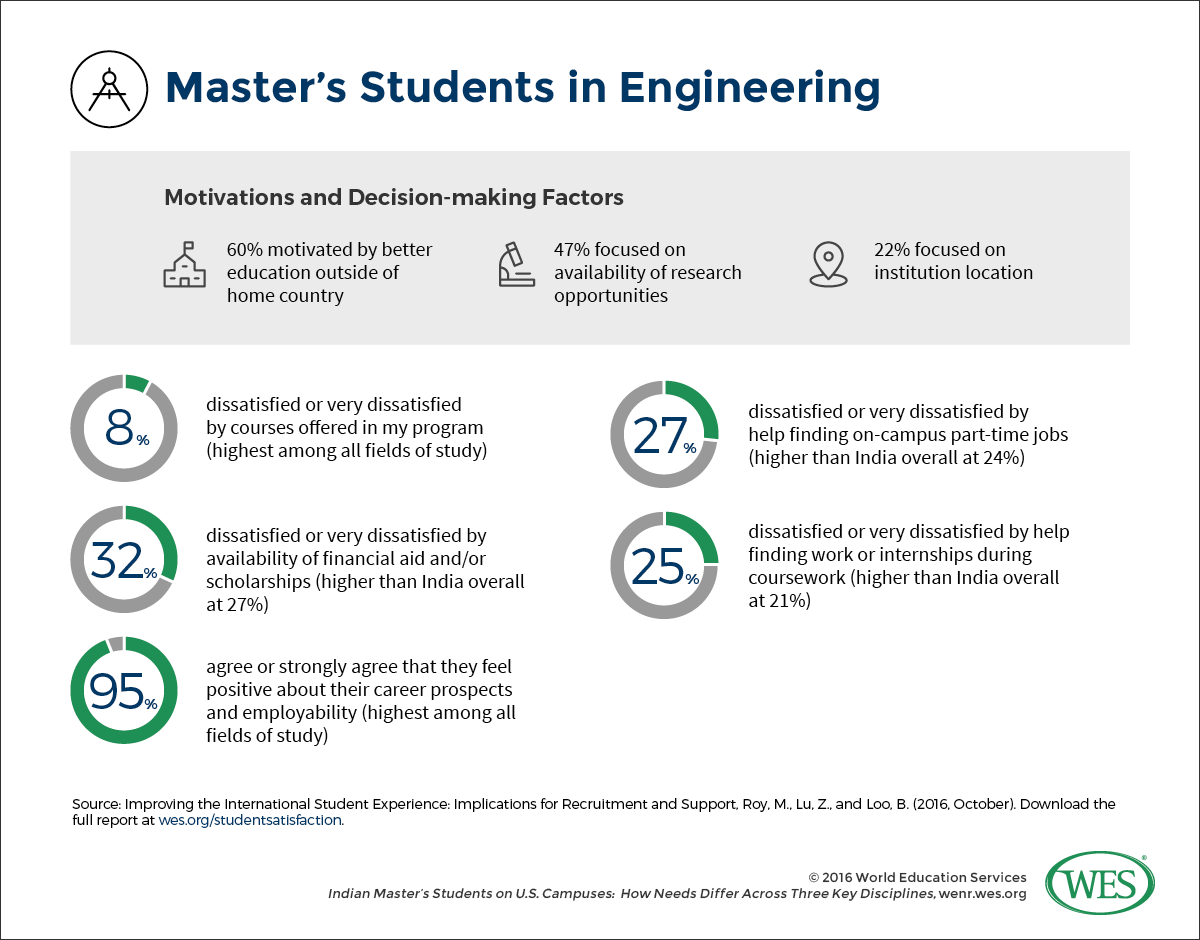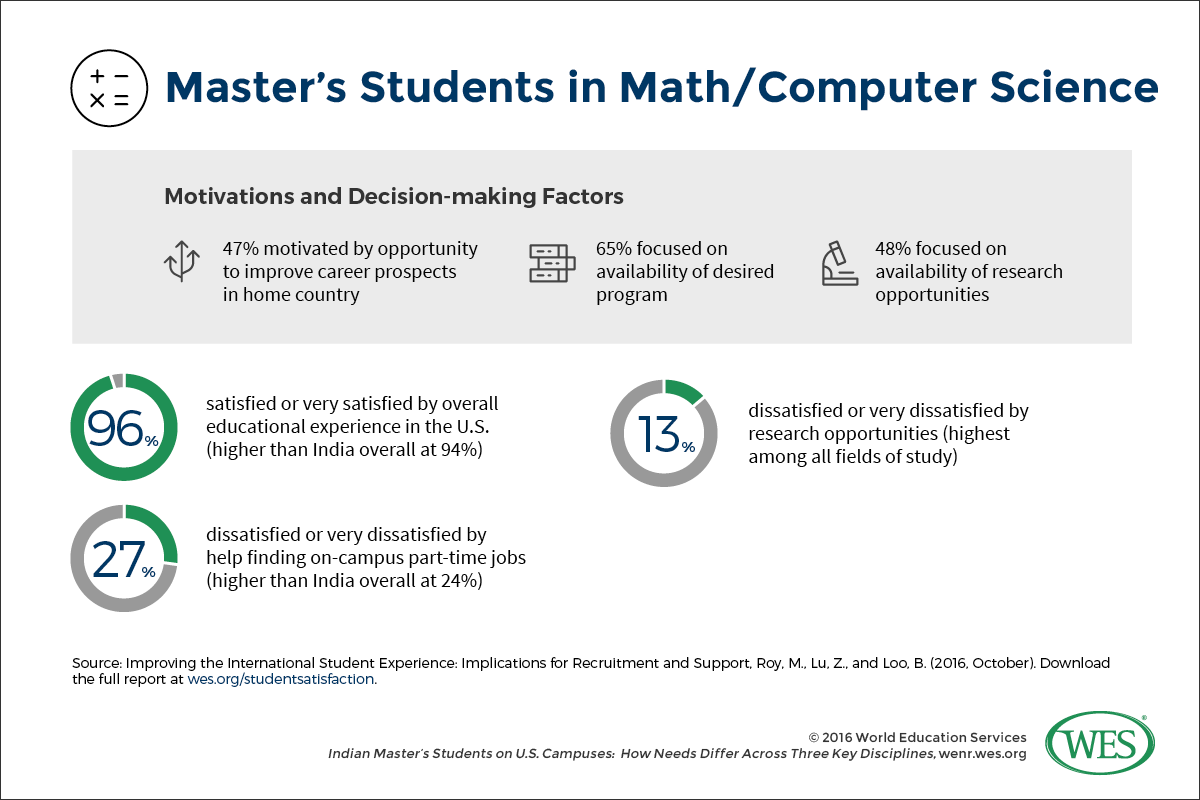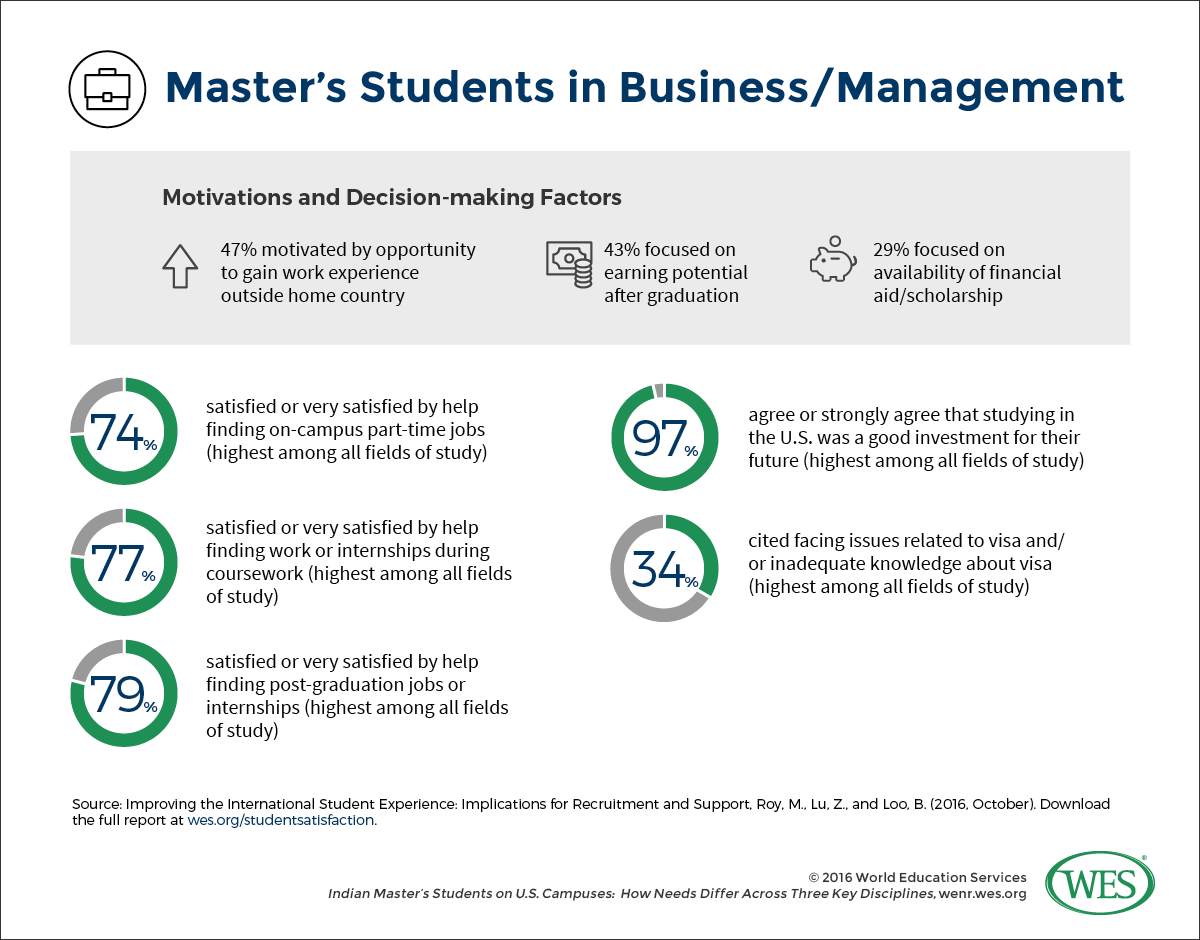Paul Schulmann, Senior Research Associate, and Megha Roy, Research Associate, WES
Indian students are a major and growing force in U.S. higher education. The most recent figures from the Institute of International Education’s (IIE) Open Doors report [1] indicate that the number of Indian students studying in the U.S. rose to 165,918 in 2015/2016, up from 132,888 the year prior. In terms of U.S.-bound international students, India’s 25 percent rate of growth outpaced that of China, which still has far and away the greatest number of students in the U.S. and was “the highest among the top 25 places of origin [2]” for international students in the U.S. IIE also reported that Indian enrollments skew heavily toward graduate schools: some 64 percent study at the master’s and doctoral levels.
On the heels of these latest numbers, we thought it would be interesting to drill deeper into WES’ most recent research [3] into international student satisfaction and motivation. Our original research report analyzed responses from students from around the world. In this article, we’ll look specifically at the experiences and motivations of Indian master’s students in three fields that account for the bulk of their enrollments overall – engineering; math/computer science; and business/management.
Indian Master’s Students in Engineering
Engineering is by far the top field of study for Indian international students in the U.S., accounting for 36 percent [5] of all Indian enrollments in 2015/16. By and large, the motivations for master’s-level Indian engineering students who pursue education abroad closely approximate those of Indian master’s students generally. For instance:
- 60 percent selected “Better education outside of my home country” as a top two motivator (identical with the broader population).
- 55 percent selected “Opportunity to gain work experience outside home country” (compared to 54 percent who selected this overall).
- The biggest factor that influenced their decision to enroll at a U.S. college or university is the “availability of research opportunities,” with 47 percent selecting it as a one of the top three factors. Among Indian students overall, the percentage is 41.
With regard to certain services, satisfaction levels among Indian engineering students at the master’s level showed more deviation from the norm. Career preparation services are a particular standout. Master’s-level Indian engineering students cited higher levels of dissatisfaction for aspects such as “Help finding on-campus part-time jobs” (27 percent) and “Help finding work or internships during coursework (e.g., CPT)” (25 percent) which were both higher than India overall (25 percent and 22 percent, respectively).
These dissatisfaction levels stand in marked contrast to Indian students’ overall satisfaction levels with regard to their U.S. educational experiences, which stood at 94 percent. These were the highest of students from all other countries and regions we analyzed in our report. It is very possible that the lower levels of satisfaction with career services or other particular aspects of their educational experiences may stem from a mismatch in expectations [6] between students’ goals and the support services available on campus. In previous articles, WES has noted a “troubling disconnect between international students and the higher education institutions that host them: On the one hand, career prospects are a major pull factor for international students who come to the U.S. On the other, the career services available are often a significant disappointment.” The evidence indicates that career services may be a particular trouble spot for master’s-level engineering students from India, among whom career prospects are a top concern.
Indian Master’s Students in Math/Computer Science
Math/computer science is the second most popular field of study for Indian students in the U.S., accounting for another 35 percent of all Indian enrollments.
Master’s-level students from this group are the most likely among their Indian peers to pursue education abroad as an “Opportunity to improve my career prospects in my home country,” with 47 percent selecting this as one of top two reasons for leaving India to study. This finding indicates that many math/computer science students from India may not be particularly interested in leveraging their educations as a path to either long-term immigration into the U.S, or an international career. Instead, they may be more interested in gaining an edge over their peers in India’s booming information technology sector, which accounts for over 10 percent of India’s exports and employs approximately 3.7 million people (NASSCOM [8]). (NOTE: The information technology business process management sector, often referred to simply as “outsourcing,” is included in this estimate.)
Of note are math/computer science students’ comparatively lower levels of satisfaction with “Research opportunities.” Thirteen percent were dissatisfied, as compared to 9 percent of the broader Indian student population.
A mismatch in expectations may again be the culprit: These same students were the most likely to list “Availability of research opportunities” as one of their top motivations for studying in the U.S. (48 percent vs. 41 percent overall).
Indian Master’s Students in Business/Management
Business/management is a distant third in terms of popularity for Indian international students. Ten percent [5] study it overall. Master’s-level Indian business/management students are the most motivated to work outside of their home country, compared to their peers in engineering and math/computer sciences. They likewise have a higher motivation to experience living in a foreign country for the work experience (60 percent) or as a pathway to immigration in the future (12 percent), compared to 54 percent and 8 percent on average. Given the benefits of intercultural competencies in an globalized business environment [10], the rationale behind these motivations is easy to understand.
In contrast to their career minded engineering peers, master’s-level Indian business students are the most satisfied with campus career services. They rated their satisfaction levels with “Help finding on-campus part-time jobs”, and help finding jobs during and after course work at 74 percent, 77 percent, and 79 percent, respectively. For Indian master’s students overall, these numbers were 69 percent, 72 percent and 65 percent.
Master’s-level business/management students are also the most likely to view their international education experiences as an avenue for increasing their earning potential. These students were the most likely to list “earning potential after graduation” as a top three influencer for studying in the U.S. (43 percent), indicating that they are acutely concerned with maximizing the return on investment for their education – perhaps no surprise given their choice of academic field. Interestingly, they were also the most likely to list “Availability of financial aid/scholarships” as a top motivator for studying in the U.S. (29 percent), likely due to the relative cost of graduate degrees in business.
Although these students levels of satisfaction were excellent across several dimensions, they were also the most likely to indicate that “Issues related to my visa and/or inadequate knowledge about visa regulations” pose a significant challenge on U.S. campuses (34 percent compared to 23 percent overall). Considering that these students’ long-term plans to “improve career and work prospect[s] outside of their home country” and to craft “pathways to immigration in future”, business students may have greater need for institutions to have a high degree of understanding of visa policies.
In October, WES published a research report entitled “Improving the International Student Experience: Implications for Recruitment and Support [3].” The report analyzed the responses of over 4,000 international students’ studying abroad (most of them in the U.S.), delving into their motivations for selecting the U.S. as a study destination and then examining their experiences once on campus. The original report detailed differences by country or region of origin. At the broadest level, our findings confirmed that most Indians view their education abroad as an important investment, one with which they have a reasonable expectation for high returns. But we believe that by looking more deeply at the specific needs and experiences of Indian master’s students in key fields, we can help institutions to better understand how to continue building on current successes. Download the full report at www.wes.org/studentsatisfaction. [12]
Recommendations for Institutions Seeking to Attract and Retain Indian Master’s Students
Our research found that nearly 95 percent of Indian students agree with the statement: “Overall, I believe studying in the U.S. was a good investment for my future”. Moreover, their overall satisfaction levels were the highest of any country or region analyzed. HEIs deserve commendations for their excellent work recruiting Indian students and providing them with great experiences on campus.
To build on this work, institutions should seek to understand and address the different motivations and experiences of Indian students in different fields in order to improve recruitment efforts and support services on campus. For example:
- Engineering students, like students in other fields, often seek to offset the cost of tuition with on-campus part-time jobs or financial aid services – but many Indian engineering students report being dissatisfied with actual job availability, and 67 percent list the cost of tuition fees as a significant challenge. Institutions should be transparent at the recruitment stage about the likelihood of procuring on-campus work and scholarships, and should ensure that students have a good understanding of the available work once they are on campus. Closing the disconnect between student’s work expectations and on-campus realities can help to ensure that word-of-mouth recommendations, which correlate to positive experiences on campus, remain positive.
- The prospect of research opportunities is a major incentive for master’s-level math/computer science students from India to study in the U.S. However, these students are the most likely to report dissatisfaction with research opportunities once on campus. This provides an opportunity for institutions with good research opportunities in the discipline to aggressively market them to prospective math/computer science students.
- Master’s level business students from India come to the U. S. primarily to improve their international career and work prospects. Institutions must ensure that their career services are capable of providing excellent services to international students, who have much more limited access to jobs and internships. They must also train career services departments to understand visa regulations, and shifting norms around optional practical training (OPT), curricular practical training (CPT), H1-B visas, and more. Institutions can market their career support services to prospective business students with a focus on the opportunities and recent job placements of their Indian peers.
Above all, it is incumbent on institutions to strive towards the goal of ensuring that Indian students have as good of educational experiences as their American counterparts. Providing positive experiences to students is not only the best method for retaining them, but also for recruiting future cohorts. Investing in student satisfaction is a strategy that pays dividends.




